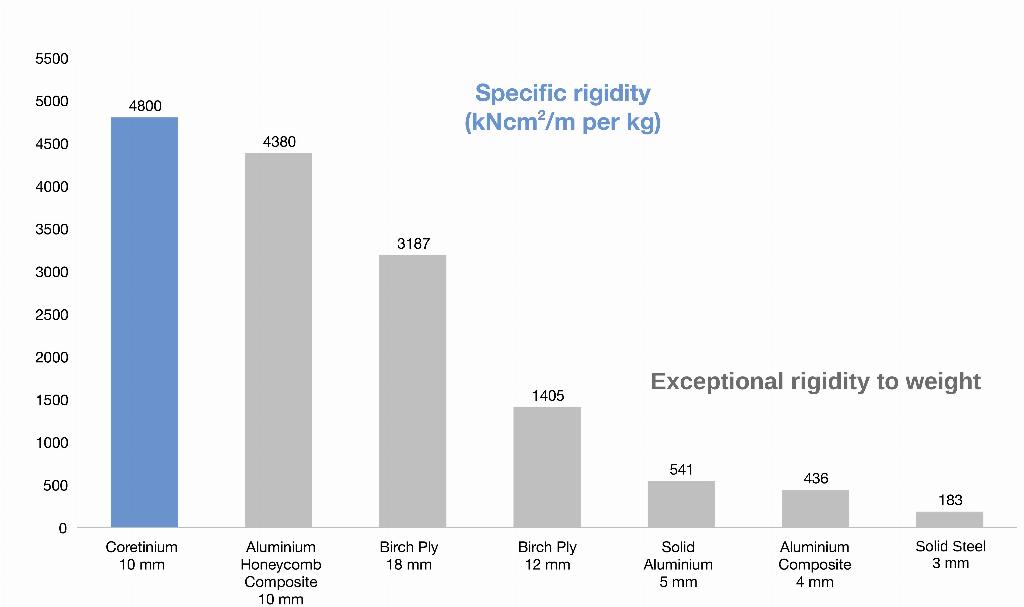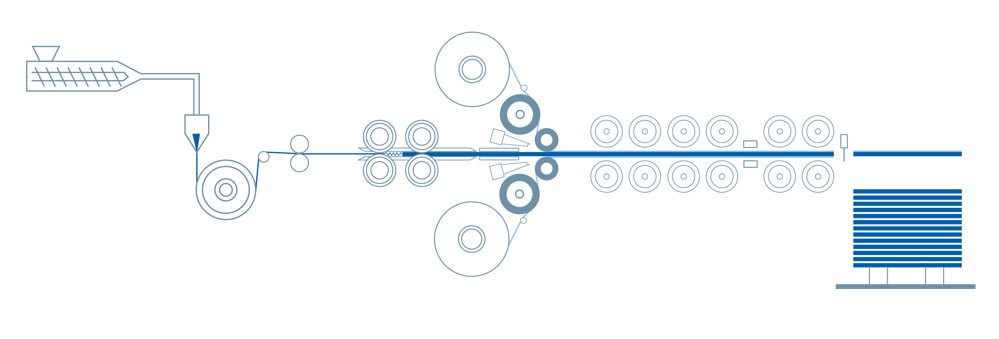Honeycomb materials lighten the load in transportation

EconCore reveals how innovative honeycomb materials are lightening the load in transportation.
EconCore has established a reputation as a leader in thermoplastic honeycomb core materials and technology. Connecting the steps of first making the honeycomb core with in-line bonding of skins to make lightweight and stiff sandwich panels has enabled EconCore to license its ThermHex process to companies around the world operating in various market sectors. The key is the technology’s versatility of materials, combined with a high-speed, continuous, cost-efficient production process. EconCore’s ThermHex process allows users to provide performance-to-weight-optimised materials with a honeycomb structure to higher-volume applications than previously possible. Instead of being limited to low-volume and less cost-sensitive domains, EconCore brings honeycomb structure to mass markets.
With the versatility to combine different core and skin materials using EconCore’s continuous, cost-efficient process technology, honeycomb core materials are finding their way into an increasing range of transportation applications. Lightweighting can lead to economic rewards and reduced environmental impact. For truck trailers and truck bodies, for example, the potential for weight reduction is compelling with honeycomb core materials being up to 90% lighter than incumbent solid cores. For fleet operators looking to reduce fuel consumption to increase cargo capacity and minimise environmental impact, the benefits are clear. Lightweighting is valuable: for a full-size trailer fuel consumption savings of 6-8% is achieved per 10% reduction in trailer weight. Lightweighting with innovative honeycomb materials is already happening and is growing rapidly. Leaders in commercial transportation in North America and Europe are adopting EconCore’s ThermHex technology and offering innovative product solutions to meet the challenges in commercial transportation and delight their customers.
Metal skins
The ability to combine thermoplastic honeycomb core materials with metal skins using the in-line, continuous ThermHex process has attracted the interest and investment of leading innovative companies in both Europe and North America. Leading the way in the UK is Tata Steel, producing Coretinium using EconCore technology which combines in-situ produced polypropylene honeycomb cores with their Colorcoat Prisma pre-finished steel skins. This breakthrough in rigidity-to-weight performance is delivering substantial value to Tata’s commercial transportation customers. One notable example is Cartwright’s new Streetwise Urban Delivery Trailer, deployed in UK cities, a half-ton lighter than before thanks to Tata Steels Coretinium composite made using EconCore technology.

Passenger transport is a demanding area that requires performance and compliance. Coretinium, with its fire-resistant steel skins, passes the industry standard R118-Annex 6. Coretinium is ideal for flooring in passenger transport vehicles. It is well suited for buses, particularly for the engine bay, where Coretinium is essentially a steel sandwich for the floor panel and fire wall, and provides a lightweight, stiff and fully compliant option for manufacturers.
Overall, with its combination of high-performance aesthetics, Coretinium is an ideal solution for reducing vehicle weight and emissions and increasing payload. We expect to see more Coretinium in transport – in applications such as bus floors and trailer side walls, as well as commercial trailer doors, floors, and recreational trailers.
In North America, Wabash National is number one in commercial transportation with a recent informal tally on US highways finding four of every 10 truck trailers emblazoned with the Wabash National logo. It is exciting for EconCore to be in the mix of Wabash’s innovation in commercial transportation. Long the leader in composite innovation with DuraPlate introduced over 20 years, Wabash is now taking it to the next level. Earlier this year Wabash showcased their DuraPlate honeycomb core panels produced using EconCore technology. For truck bodies, the opportunity is clear, these panels are engineered to provide optimal weight to performance for their final-mile applications. The honeycomb core panels are 22% lighter than solid-core composite panels, and for truck bodies the lighter panels are more durable than current products. The adoption of honeycomb technology for truck bodies is building momentum this year and significant manufacturing capacity is in the works for 2019.
Reinforced thermoplastic composite skins
Together with its subsidiary ThermHex Waben and Fraunhofer IMWS, EconCore is putting much effort into application and process developments for the EU-funded project Organosandwich, a material made of thermoplastic honeycomb cores with composite skins reinforced with continuous glass fibres. Complementing and adding to the range of material combinations for commercial trailers, Organosandwich materials provide another means to reduce weight and improve the bottom line. Comparing, for example, a trailer made with traditional GRP laminated plywood to an Organosandwich made of a polypropylene (PP) honeycomb core with PP/GF composite skins, the Organosandwiches are more than 60% lighter, and for a trailer made of traditional GRP and plywood initially weighing 6.5 metric tons, the weight savings is approximately 18% (1.15 tons) when made with Organosandwich materials. This translates to significant fuel savings or increased cargo capacity per unit and, when scaled to even a medium-sized fleet, this is enormous.

Consider that for a fleet manager having 100 units, with a total weight of a typical pulling tractor-trailer assembly of 13 tons and where a truck makes 100,000km/year on average and consumes 40 litres of diesel per 100km, such a 1.15-ton reduction may mean equal a fuel savings of roughly 250,000 litres. Over a few years, such fuel reductions would result in cost savings ranging in the millions of euros. It is up to the fleet manager to decide how to apply the value from the lightweighting – be it in fuel savings or increased payload, or a balance of both.
A further innovative application of Organosandwich materials may include taking advantage of the ability to make light-transmitting panels that can be installed as daylighting panels in trailer and truck body roofs.
Organosandwich is an intrinsically stiff material and lightweight due to the low-density honeycomb core. With the drive to replace heavy parts with lighter ones and the goal to ultimately reduce CO2 emissions, Organosandwich materials are being considered for a wide range of transportation applications. These materials provide excellent rigidity and the impact-resistant properties needed for the automotive industry, and at a lower weight than traditional heavy parts. With the drive for lightweight solutions in transportation industry, the future is bright for Organosandwich materials, for fleet managers and vehicle owners, and for the environment.
Visit ThermHex Waben and EconCore at the IAA Commercial Vehicles in Hannover, September 20-27, 2018. Booth E35, hall 24.









